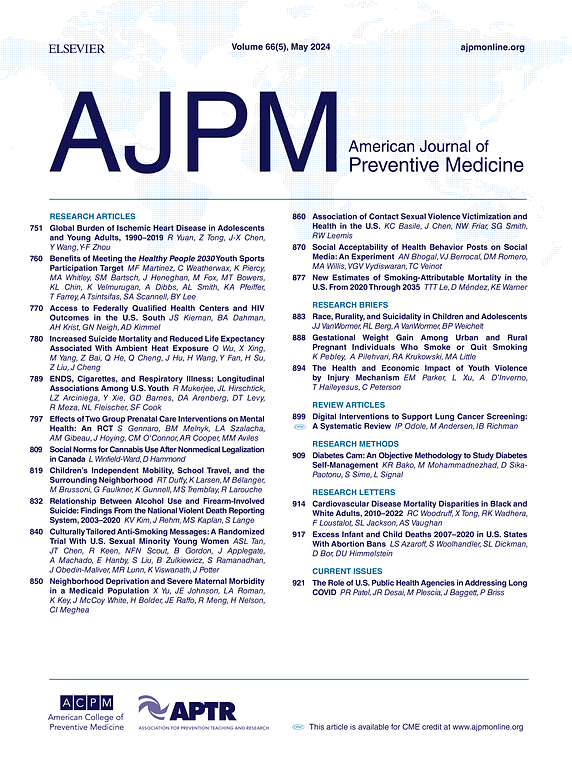Impact and Cost-Effectiveness of a Home Food Environment Intervention on Healthy Eating
IF 4.5
2区 医学
Q1 MEDICINE, GENERAL & INTERNAL
引用次数: 0
Abstract
Introduction
Multiple aspects of the home food environment shape dietary patterns. The purpose of this study was to test a more scalable version of an intervention designed to promote healthy eating by improving home food environments, and to determine its cost-effectiveness.
Methods
Healthy Homes/Healthy Families (HH/HF) is a 3-month program alternating weekly coaching calls and text messages to encourage healthy eating by creating healthier home food environment through 8 healthy actions. Healthy Homes/Healthy Families was evaluated in a randomized controlled trial with follow-up at 4 and 9 months post-baseline (2020–2023). Participants were clients of four United Way 2-1-1 information and referral organizations in Georgia. The primary outcome was the Healthy Eating Index (HEI-2015), calculated from two 24-hour dietary food recalls. Data were analyzed in 2023–2024..
Results
The majority of participants (n=510) were women (91.6%) and identified as African American or Black (82.7%). The HEI-2015 improved more (3.26 units, p=0.005) for the intervention than control group at 9 months in intent-to-treat analyses. Both total fruits (0.53, p=0.009) and added sugar (0.81, p=0.004) HEI-2015 domain scores also improved significantly. Multiple aspects of the home food environment improved in a desired direction, including inventories of unhealthy snacks/foods, food preparation and food serving practices, family meals from non-home food sources, and frequency of family meals and snacks while watching TV. Costs averaged $85 per participant ($95 for full program delivery); costs per unit HEI increase were $26. The intervention is cost-effective, with a cost per quality-adjusted life year of $28,762. The intervention is cost-saving as long as the benefits last 3 years or longer.
Conclusions
The intervention was effective in promoting modest changes in diet quality by improving home food environments.
家庭食物环境干预对健康饮食的影响及成本效益。
家庭饮食环境的多个方面塑造了饮食模式。本研究的目的是测试一个更可扩展的干预版本,旨在通过改善家庭食品环境来促进健康饮食,并确定其成本效益。研究设计:一项随机对照试验,在基线后4个月和9个月(2020-2023)进行随访。环境/参与者:参与者是佐治亚州四个联合劝募2-1-1信息和转诊组织的客户。干预:健康家庭/健康家庭是一个为期三个月的项目,每周交替进行电话指导和短信指导,通过八项健康行动创造更健康的家庭饮食环境,鼓励健康饮食。主要结局指标:健康饮食指数(HEI-2015)是根据两次24小时膳食食品召回计算得出的。数据分析时间为2023-2024年。结果:大多数参与者(n=510)是女性(91.6%),被确定为非洲裔美国人或黑人(82.7%)。在意向治疗分析中,干预组的HEI-2015改善更多(3.26个单位,p= 0.005)。水果总量(0.53,p= 0.009)和添加糖(0.81,p= 0.004)的HEI-2015域得分也显著提高。家庭食品环境的多个方面朝着预期的方向得到改善,包括不健康零食/食品的库存、食品准备和食品服务做法、非家庭食品来源的家庭用餐以及家庭在看电视时用餐和零食的频率。每位参与者的平均费用为85美元(完整课程交付费用为95美元);每单位HEI增加的成本为26美元。该干预措施具有成本效益,每个质量调整生命年的成本为28,762美元。只要效果能持续三年或更长时间,这种干预就能节省成本。结论:通过改善家庭饮食环境,干预对促进饮食质量的适度改变是有效的。
本文章由计算机程序翻译,如有差异,请以英文原文为准。
求助全文
约1分钟内获得全文
求助全文
来源期刊

American Journal of Preventive Medicine
医学-公共卫生、环境卫生与职业卫生
CiteScore
8.60
自引率
1.80%
发文量
395
审稿时长
32 days
期刊介绍:
The American Journal of Preventive Medicine is the official journal of the American College of Preventive Medicine and the Association for Prevention Teaching and Research. It publishes articles in the areas of prevention research, teaching, practice and policy. Original research is published on interventions aimed at the prevention of chronic and acute disease and the promotion of individual and community health.
Of particular emphasis are papers that address the primary and secondary prevention of important clinical, behavioral and public health issues such as injury and violence, infectious disease, women''s health, smoking, sedentary behaviors and physical activity, nutrition, diabetes, obesity, and substance use disorders. Papers also address educational initiatives aimed at improving the ability of health professionals to provide effective clinical prevention and public health services. Papers on health services research pertinent to prevention and public health are also published. The journal also publishes official policy statements from the two co-sponsoring organizations, review articles, media reviews, and editorials. Finally, the journal periodically publishes supplements and special theme issues devoted to areas of current interest to the prevention community.
 求助内容:
求助内容: 应助结果提醒方式:
应助结果提醒方式:


